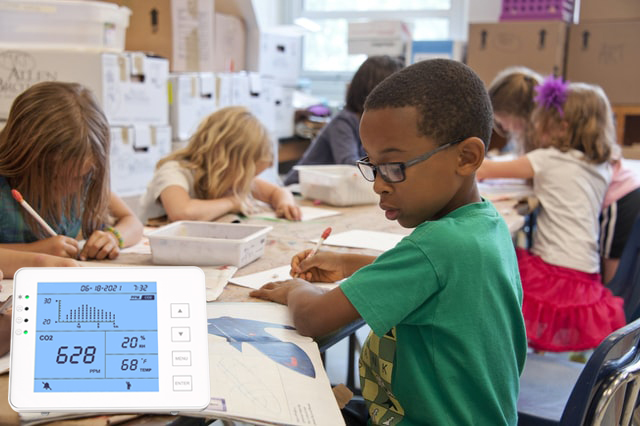So long as the carbon dioxide levels in classrooms are less than 1000 ppm, children are secure there. Due to the pandemic, CO2 has taken on significance in our lives as it is directly related to the quantity of airborne pathogens. The good news is that COVID-19 has caused schools to take indoor air quality considerably more seriously. School districts are actively enhancing ventilation and carbon dioxide monitoring to keep our children safe.

What ought to the CO2 concentration be in a classroom?
The CO2 level in the classroom should be roughly 413 ppm, which is the same as the outside CO2 level. To do this, though, requires leaving all windows and doors open for air exchange, which is not always feasible.
Lower than 1100 ppm indoor CO2 levels are regarded as tolerable.
What is the outdoor CO2 concentration?
You may have heard that as a result of global warming, the level of CO2 in the air has been gradually rising. About 413 ppm of carbon dioxide were present in the atmosphere in 2021. In other words, the CO2 content of the air around us is around 0.0413 percent.
How Is CO2 Produced In A Classroom?
The classroom fills up with carbon dioxide as pupils exhale. The CO2 level gradually starts to rise above the nominal 413 ppm level.
Indoor carbon dioxide levels can reach far over 1000 ppm and even up to 3000 ppm. The amount of fresh air drawn into the classroom, the number of pupils, and the volume all affect the absolute CO2 level that is attained.
In general, a high CO2 concentration is dangerous since it has negative impacts on kids.
How Does CO2 Affect the Spread of Airborne Viruses?
When speaking, singing, or breathing, students also exhale CO2 and tiny droplets. These dispersed particles may include infections that can linger in the air for hours for sick students.
As we breathe out more and more, our immediate environment’s CO2 levels and airborne virus concentrations start to increase.
Has a Scientific Link Been Found Between CO2 Levels and the Risk of Virus Infection?
Indeed it has. Researchers from the University of Colorado, Harvard School of Public Health, and MIT have conducted studies that demonstrate this connection.
The Technical University of Berlin demonstrated that raising the amount of clean air lowers the amounts of CO2 and other pollutants inside buildings. This kind of ventilation with fresh air reduces the danger of contracting an infection.
Academics have come to the conclusion that minimizing CO2 levels will assist lower the danger of infection after extensive investigation. Many school districts across the world have adopted CO2 monitoring in the classroom, recognizing the importance of aerosol monitoring as a first step.
How Can CO2 Levels Be Measured in a Classroom?
A carbon dioxide monitor is used to measure carbon dioxide. The sensor cell in this device detects CO2 molecules using infrared light.
The CO2 molecules absorb the infrared radiation, warming the Earth similarly to the greenhouse gas effect. Electrical equipment can detect this shift because CO2 molecules absorb light. The drop in infrared light received is detected by a photodetector, and the output signal is proportional to the CO2 gas concentration.
Do CO2 Monitors Need to Be in Classrooms?
The kind of monitors required vary by state, city, and county. For instance, California now mandates that classrooms contain carbon dioxide monitors to ensure optimum ventilation. Additionally, it minimizes the possibility of virus transmission, inhalation, and infection.
The California legislature enacted AB841AB-841, mandating CO2 monitoring in all classrooms, in 2021.
What Conditions Must CO2 Monitors Meet in Californian Classrooms?
- A CO2 monitor must be attached to the wall between three and six feet above the ground, at least five feet away from an operable window or door, and in compliance with AB841.
- The monitor must use an on-device display to show the instructor the carbon dioxide measurements.
- When the carbon dioxide levels in the classroom reach 1100 ppm or higher, the monitor is required to send a signal via a visual indication or another alarm mechanism.
- Previous data, including the highest carbon dioxide content ever measured, must be kept on file by the monitor.
- The monitor’s range must be between 400 and 2000 parts per million.
- The producer of the monitor must certify its accuracy to within 75 ppm at 1,000 ppm of carbon dioxide. Additionally, the gadget must work correctly and be calibrated at least once every five years.
What Is the Optimal CO2 Level Indoors?
We have gathered some fascinating suggested indoor CO2 levels. They consist of the following:
- AB841 was passed by the California State Legislature, requiring classrooms to monitor CO2 and sound an alert at 1100 ppm.
- Restaurants must monitor their CO2 levels, and Washington State mandates that the monitor sound an alarm at 450 ppm.
- For offices and schools, the American Society of Heating, Refrigerating, and Air-Conditioning Engineers advises keeping indoor CO2 concentrations below 800 ppm.
- The Federal Environment Agency of Germany advises against exceeding 1,000 ppm in offices and classrooms.
- In Ireland, classrooms with subpar ventilation are getting CO2 monitors fitted.
- Any CO2 content between 1,000 and 2,000 ppm is categorized as dubious by Germany’s Federal Environment Agency, while anything over 2,000 ppm is unacceptable.
Which CO2 Monitor Is Best for Classrooms?
For use in a classroom, a monitor should preferably comply with AB841 criteria. In classrooms all around California, CO2 monitors that have been created with this usage in mind are employed.

Last Words
Schools are enhancing interior air quality since the pandemic by using optimal ventilation and CO2 monitoring. To keep our teachers and children safe in the classroom, we must take these important steps.
If any steps have been done to improve the air quality in the classroom, you might like to inquire with your local school district. It is crucial to comprehend any new procedures, ventilation setups, or CO2 monitors they have embraced or intend to use.

Leave A Comment